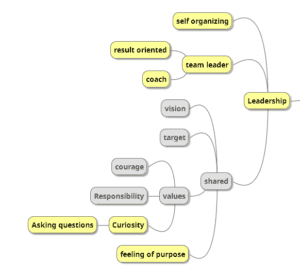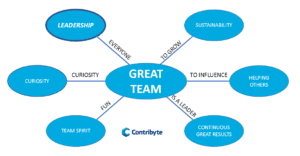Even Strong Teams Need Leadership
Even Strong Teams Need Leadership
Leadership – The Second Cornerstone of a Good Team
Last time in this series on good teams, we discussed curiosity and awareness, possibly two of the most important factors of a good team. While curiosity is essential, we must take care of all six cornerstones of a good team.
This time, we will look into leadership. As we all know, leadership has existed since time immemorial. Before our ancestors, and even before we were humans, we have been social animals led by a leader. Throughout history, leadership has been widely talked and written about and researched. You are sure to find tens of thousands of books from Amazon’s business leadership category alone. People are interested in the subject because the leader has an enormous role in the team’s success and well-being.
Agile teams cannot, however, be led according to a traditional leadership model. A model where one leader is in charge, making all the decisions, does not work for agile teams. Teams and team members must learn self-management. Does that mean that the team has no leader at all? On the contrary! If the team members need to manage themselves, the team leader must be even better and wiser!
You could say that the leader of an agile team must be like a team member, but at the same time, act as the team’s guide and coach. Let’s take a look at Contribyte’s model for good teams.
Self-management Is Part of Leadership
In the Contribyte model, leadership is divided into the following elements: self-management and the values, purpose, and vision maintaining the cohesion of the team, in other words, the team’s direction.

Self-managing Teams Are Strong
People talk a lot about self-management: people and teams should be able to work as independently as possible. First of all, the purpose of self-management is to enhance decision-making by having the decisions made by those with the right kind of expertise. By giving people power and responsibility for their own work, they are more likely to feel ownership of their work and aim for the best results. The more the team can self-manage their tasks, the better the team.
Self-management Requires Leadership
What does self-management require? Can you just tell your team that you will be off to Málaga and leave them to do all the work? This approach is unlikely to produce good results. You might even end up like Lieutenant Dike in Band of Brothers. This is why leadership is part of our good team model instead of self-management. Along with traditional leadership, leadership includes self-management.
Self-management can be difficult! It requires knowledge, skills, and understanding of the vision and goals from the team and its members. As well as efficient communication. If we compare a traditionally led team to an efficient self-managing team, the self-managing team communicates a lot more and its members are aware of where they are and where they should be headed. As corny as it sounds, this is very likely to require a leader.
The Leader Shows the Direction
In a self-managing team, the role of the team leader is to ensure that everyone is going to the right direction as well as to facilitate and coach the team to manage their own tasks even better. The most efficient way of doing this is through feedback. People want to do a good job and they love to receive feedback, especially if they work in a team. Feedback is extremely important. The leader of a self-managing team should make sure that all team members receive enough feedback. This does not mean that the leader should be the one to give the feedback. Instead, the leader should make sure that the team members understand the value of feedback and have agreed on how to give it.
In agile teams the team leader (or if the leader is not present, the Scrum Master) is responsible for coaching the team members to give enough feedback to others.

Self-management and Good Leadership Increase Trust
A good leader ensures that the team is aware of its goal and that each team member understands their role and receives encouragement and coaching. As a result, the team becomes more motivated. This usually leads to better results. By delivering results, the team creates a positive cycle where good results are followed by even better results. Everyone can see how the team members help each other move forward. In these kinds of teams, the team members can trust their own strengths and each other. The team begins to feel like they could achieve anything. In this case, the leader might even want to consider holding the team back a bit!
Different Backgrounds – Same Purpose
Diversity, the different skills and backgrounds of the team members, has a positive effect on the team. Different views and ideas keep the team fresh, but they should be grounded with a shared purpose and values. All team members should agree on why the team exists and what its mission and values are. That is a good basis for defining the tactical direction.
What could be our philosopher’s stone? What could be the best way to ensure that the team has a good leader and enough self-management? We cannot offer you a solution that fits every situation. Leadership development is always a challenge but understanding what needs improvement is a great start. Does your team know their goal? What are your team’s values? These questions can be discussed in a workshop. Ask your team for their opinions and listen to them.

Arto Kiiskinen
Senior Consultant
In his career, Arto has worked in product development as a Product Owner, Scrum Master and Product Development Manager. The operating methods of both large and small companies have become familiar. Arto loves to improve organizational learning and product owner know-how, and write blogs on different topics. Because retrospectives are one of Arto’s favorite topics, some of his customers have given him the nickname “Retroman”. During his free time, Arto tries to live healthy, buy as many cars as possible, rewatch the Star Gate series and study to become a Personal Trainer. Arto has also written the book “OWN IT – 8 Simple Secrets of Product Owner Success”.





